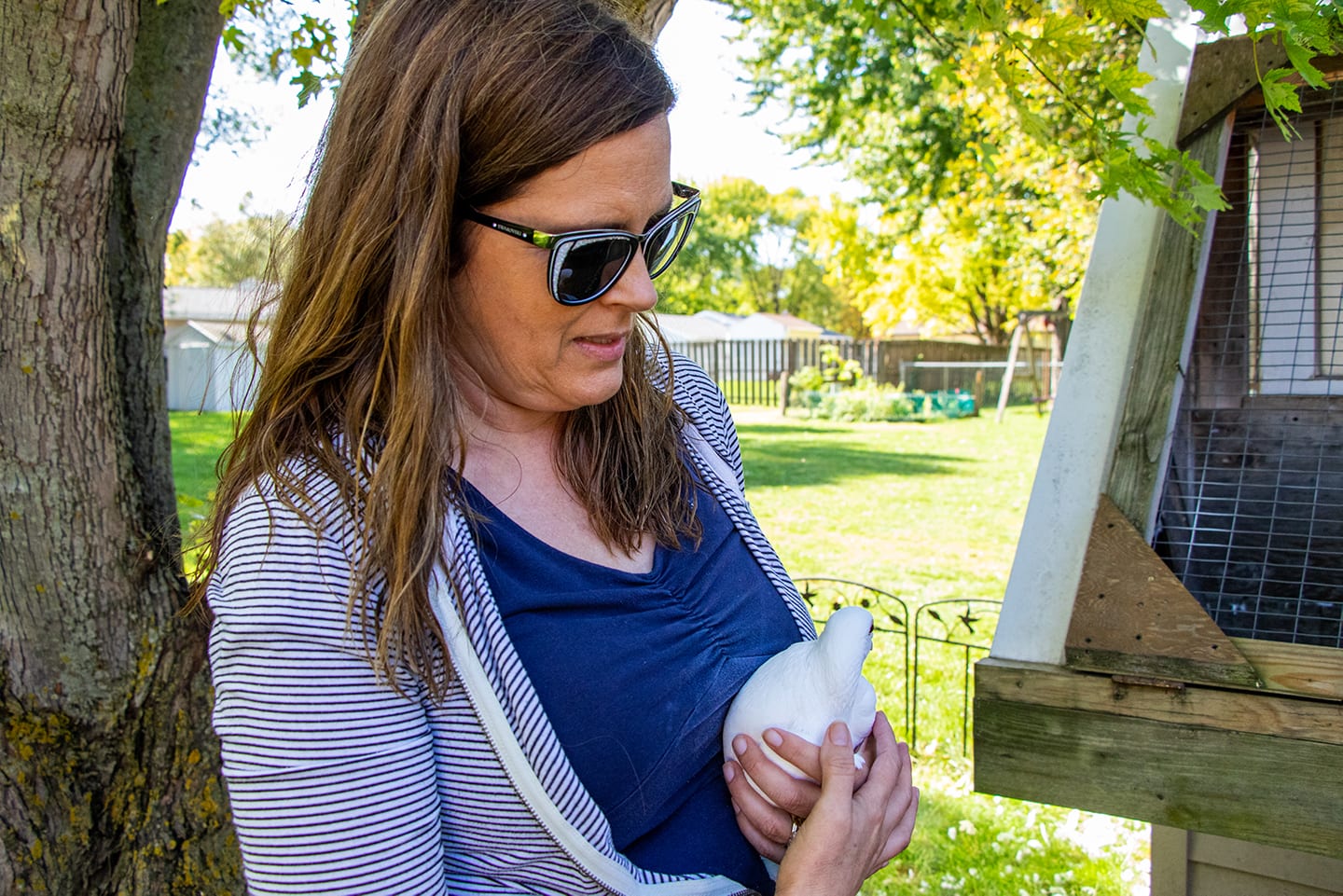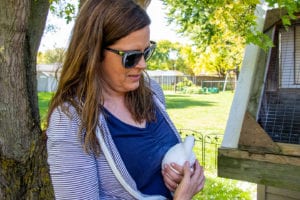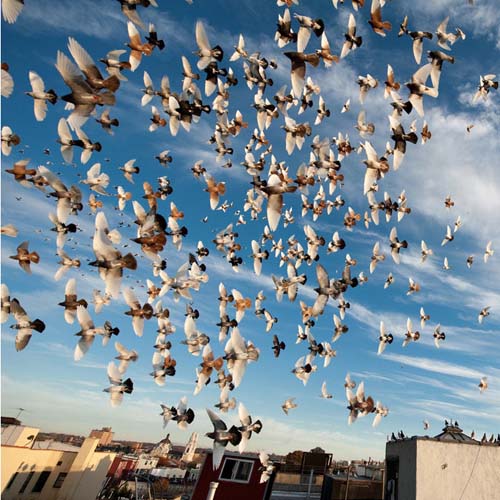
by Pigeon Patrol | Oct 18, 2019 | Animal Deterrent Products, Bird Deterrent Products, Bird Netting, Bird Spikes, Pigeon Control, Pigeon Droppings, Pigeon Patrol's Services, Pigeon Spikes
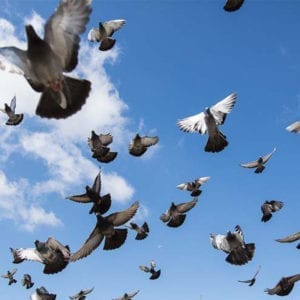
Revealed: the mechanism that allows birds of a feather to flock together
Pigeons loaded with GPS backpacks show the secrets of co-ordinated flight control
Anyone interested in the democratic process could do worse than study the group decisions made by pigeons in mid-flight. Scientists have discovered that pigeon flocks are governed by a kind of “democratic hierarchy” that makes sure everyone flies in the same direction.
With the help of tiny GPS backpacks carried by each member of a loft of pigeons, researchers have discovered how large numbers of animals are able to instantly co-ordinate their movements to ensure that they do things as a group rather than as anarchic individuals.
Although the principle has so far only been demonstrated with a smallish flock of Hungarian pigeons, the scientists believe it could also operate on much bigger groups of animals, such as schools of fish and herds of wild buffalo, and might even explain how close-knit groups of people, such as juries, manage to reach a single decision.
“Anyone who has seen flocks of birds or schools of fish is familiar with this phenomenon of large numbers of individuals in a fast-moving group appearing to move in a co-ordinated way, and it’s not immediately clear how they coordinate themselves,” said Dora Biro, a zoologist at Oxford University.
“Our question was, how do groups like flocks of pigeons make decisions about what to do and where to go?” Dr Biro said.
The GPS backpacks carried by the pigeons enabled the scientists to precisely monitor the birds’ movements, relative to each other, every 0.2 seconds of their journey from the point where the scientists released them to their home loft in Budapest, 15km away.
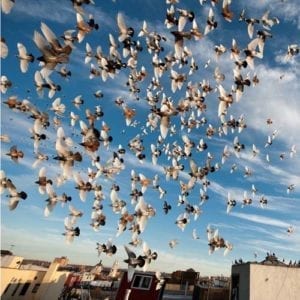
“Previously, people had assumed democratic decisions, where every bird’s preferences are somehow averaged out, and that’s what the group ends up doing. Or there might be a single leader or a small number of leaders that everyone follows,” Dr Biro said.
“But what we were able to do by tracking these birds with individual GPS units was to resolve the leader-follower relationship within the flock. What we found was a more sophisticated and refined mechanism for how the decisions are made,” she said.
“There wasn’t a single leader, nor was there a kind of egalitarian decision-making where everyone had an equal vote. Instead, each bird did have a vote, but the weight that each vote carried differed between birds.
“It represented a kind of hierarchy where the decisions of some birds near the top of the hierarchy carried more weight in terms of what the birds did than the birds lower down the hierarchy, who were still influential but to a lesser degree,” said Dr Biro, who carried out the study with Tamás Vicsek of Eötvös University in Budapest.
“Whether such effects come from some individuals being more motivated to lead, or being inherently better navigators perhaps with greater navigational knowledge, is an intriguing question we don’t yet have an answer to,” Dr Biro said.
The loft of pigeons in the study consisted of 10 birds whose every movement was recorded as they flew in a flock from one location to another. The analysis, published in the journal Nature, described how each bird moved in relation to its neighbours, with some individuals leading more than others.
“It’s neither a completely democratic system, where everybody gets the vote, nor [one with] a single leader or a few leaders responsible for the decisions. But in fact every individual gets a kind of input into what the group as a whole should do,” Dr Biro said.
“If this was honed by evolution, if there was a selective advantage for individuals in the group to make decisions in this way, then it might represent a particularly efficient form of group decision making… It is possible that the mechanism we saw in these pigeons generalises to other species and to other group decision-making contexts, even in humans,” Dr Biro said.
About Pigeon Patrol:
Pigeon Patrol Products & Services is the leading manufacturer and distributor of bird deterrent (control) products in Canada. Pigeon Patrol products have solved pest bird problems in industrial, commercial, and residential settings since 2000, by using safe and humane bird deterrents with only bird and animal friendly solutions. At Pigeon Patrol, we manufacture and offer a variety of bird deterrents, ranging from Ultra-flex Bird Spikes with UV protection, Bird Netting, 4-S Gel and the best Ultrasonic and audible sound devices on the market today.
Contact us at 1- 877– 4– NO-BIRD, (604) 585-9279 or visit our website at www.pigeonpatrol.ca
Bird Gone, Pigeon Gone, Pigeon problems, pigeon spikes, 1-877-4NO-BIRD, 4-S Gel, Bird Control, Pigeon Control, bird repellent, Bird Spikes, sonic bird repellent, stainless steel bird spikes, bird spikes Vancouver, Ultra Sonic Bird Control, Bird Netting, Plastic Bird Spikes, Canada bird spike deterrents, Pigeon Pests, B Gone Pigeon, Pigeon Patrol, pest controller, pest control operator, pest control technician, Pigeon Control Products, humane pigeon spikes, pigeon deterrents, pigeon traps, Pigeon repellents, Sound & Laser Deterrents, wildlife control, raccoon, skunk, squirrel deterrent, De-Fence Spikes, Dragons Den.

by Pigeon Patrol | Aug 24, 2019 | Bird Netting

For pigeons, it seems, leadership is largely a question of speed.
Researchers compared pigeons’ relative influence over flock direction to their solo flight characteristics. The studies showed that a pigeon’s degree of leadership could be predicted by its speed in earlier flights.
“This changes our understanding of how the flocks are structured and why flocks of this species have consistent leadership hierarchies,” said Dora Biro of the University of Oxford in London.
The latest GPS loggers allow the researchers to track not only the birds’ overall routes, but also the sub-second time delays with which they react to each other while flying as a flock.
“We can control the composition of the flocks and the starting points for their homeward journeys,” said Benjamin Pettit, first author of the study.
When the researchers tested the birds individually after a series of flock flights, they found that leaders had learned straighter homing routes than followers.
The new findings offer an elegantly simple explanation for the phenomenon of leadership in birds, with important implications for how spatial knowledge is generated and retained in navigating flocks.
“We also have a good understanding of their individual spatial cognition, in particular how their homing routes develop over repeated flights in the same area,” Pettit noted.
“Some birds are naturally faster and consistently get to the front, where they end up doing more of the navigation, which means on future flights they know the way better,” Biro added.
“You can compare this to a ‘passenger-driver’ like effect: drivers in a car have to pay attention while passengers are often unable to recall the route they were driven along, especially if they remained passive in the navigation process,” Biro explained.
A very simple, self-organising mechanism–such as that based on variation in speed–is sufficient for leadership to arise.
Have a Pigeon Problem?
Pigeon Patrol Products & Services is the leading manufacturer and distributor of bird deterrent (control) products in Canada. Pigeon Patrol products have solved pest bird problems in industrial, commercial, and residential settings since 2000, by using safe and humane bird deterrents with only bird and animal friendly solutions. At Pigeon Patrol, we manufacture and offer a variety of bird deterrents, ranging from Ultra-flex Bird Spikes with UV protection, Bird Netting, 4-S Gel and the best Ultrasonic and audible sound devices on the market today.
Voted Best Canadian wholesaler for Bird Deterrent products eight years in a row.
Contact us at 1- 877– 4– NO-BIRD, (604) 585-9279, or visit our website at www.pigeonpatrol.ca
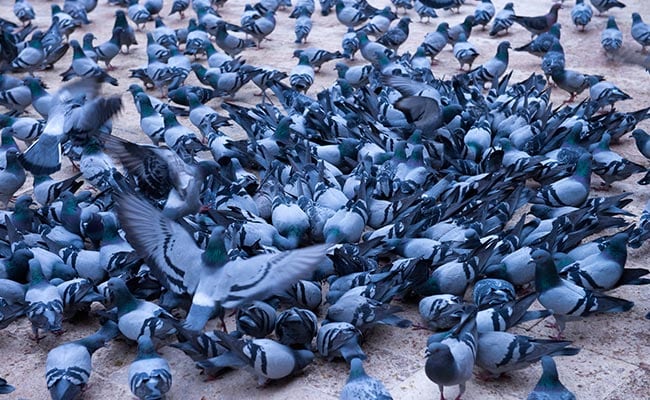
by Pigeon Patrol | Aug 23, 2019 | 4-S Gel Bird repellent, Animal Deterrent Products, Bird Deterrent Products, Bird Netting, Bird Spike, Bird Spikes, Pigeon Control, Pigeon Droppings, Pigeon Patrol's Services, Pigeon Spikes, Pigeons in the News, UltraSonic Bird Control

CHENNAI: A number of pigeons are swarming the Chennai airport premises for the last three days. Authorities were forced to hire a nomadic community to shoo them away.
Efforts by the airport personnel to shoo them away have failed; as the birds come back again and again, giving anxious moments to the authorities.
Many birds were spotted around the runway today, authorities requisitioned the services of Narikorava community, who are well versed in shooing them away using traditional techniques.
The gypsies were on the job to shoo the birds away, and have been very successful.
As part of the State Safety Programme, preventing wildlife (bird/animal) strikes to aircraft was identified by Directorate General of Civil Aviation as one of the most important safety priorities.
Have a Pigeon Problem?
Pigeon Patrol Products & Services is the leading manufacturer and distributor of bird deterrent (control) products in Canada. Pigeon Patrol products have solved pest bird problems in industrial, commercial, and residential settings since 2000, by using safe and humane bird deterrents with only bird and animal friendly solutions. At Pigeon Patrol, we manufacture and offer a variety of bird deterrents, ranging from Ultra-flex Bird Spikes with UV protection, Bird Netting, 4-S Gel and the best Ultrasonic and audible sound devices on the market today.
Voted Best Canadian wholesaler for Bird Deterrent products eight years in a row.
Contact us at 1- 877– 4– NO-BIRD, (604) 585-9279, or visit our website at www.pigeonpatrol.ca
 Kandy Noles Stevens holds a homing pigeon outside her home in Marshall, Minnesota. Stevens commutes to Vermillion once a week to teach physical science for elementary in the School of Education. Lauren Soulek | The Volante
Kandy Noles Stevens holds a homing pigeon outside her home in Marshall, Minnesota. Stevens commutes to Vermillion once a week to teach physical science for elementary in the School of Education. Lauren Soulek | The Volante Though a theory on why homing pigeons know how to navigate over vast distances, some scientists say they use earth’s magnetic field as a guide.
Though a theory on why homing pigeons know how to navigate over vast distances, some scientists say they use earth’s magnetic field as a guide.
